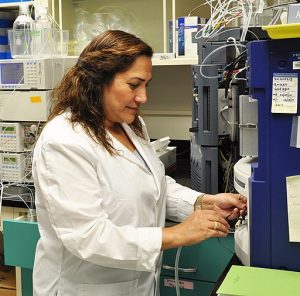1.1 What is Organic Chemistry?
In the game “20 Questions,” one player thinks of something and another is tasked with discovering what that thing is through a process of questioning. Up to 20 questions can be asked in an attempt to hone in on the answer. Frequently a questioner will ask “Animal, Vegetable, or Mineral?” early in the questioning, to narrow all the possible options down quickly. Of all the stuff in the universe, just about anything can be dropped into one of these categories.

Students of chemistry often are introduced quite early to a set of similarly broad categories: pure substances are classified as ionic, molecular (covalent) or metallic. Interestingly, these categories have some significant overlap with the categories from the 20 Questions: animals and vegetables are mostly composed of the elements carbon, hydrogen and oxygen and have other features characteristic of molecular substances. The materials they are made of can be burned in oxygen to yield carbon dioxide and water, and they may be present in any of three common physical states (solid, liquid, gas) under normal room conditions. They are mostly covalent in nature. In contrast, minerals typically contain metal as well as nonmetal elements and have features characteristic of ionic substances. They do not combust, they are usually solids under normal conditions and sometimes have recognizable crystalline structures. In certain conditions high heat can cause them to react to release pure metals–shiny, ductile and conductive materials that harden as they cool to form shiny solids.
General Contrasting Properties and Examples of Organic and Inorganic Compounds
| Organic | Hexane | Inorganic | NaCl | |
|---|---|---|---|---|
| low melting points | −95°C | high melting points | 801°C | |
| low boiling points | 69°C | high boiling points | 1,413°C | |
| low solubility in water; high solubility in nonpolar solvents | insoluble in water; soluble in gasoline | greater solubility in water; low solubility in nonpolar solvents | soluble in water; insoluble in gasoline | |
| flammable | highly flammable | nonflammable | nonflammable | |
| aqueous solutions do not conduct electricity | nonconductive | aqueous solutions conduct electricity | conductive in aqueous solution | |
| exhibit covalent bonding | covalent bonds | exhibit ionic bonding | ionic bonds |
Given these general links, it may seem reasonable to think there might be some fundamental distinction between chemical substances that come from living things (animals and vegetables) and those that come from the rocky earth (mineral). Is the chemistry of living things fundamentally different than that of non-living things?
Not so long ago, people believed there was such a fundamental difference. This view called vitalism, that living and nonliving material was fundamentally different, was generally accepted within and outside of scientific circles through much of the 1700s.
Experimental evidence began to reveal inconsistencies between this view and reality, however. In 1828 a German chemist named Friederich Wohler provided what may have been the final blow to the idea: he took material from the non-living world and used it to produce urea, a known biochemical. The urea he produced was exactly the same stuff as the biologically sourced urea. They were indistinguishable.
Wohler’s discovery wasn’t planned. When he reacted silver cyanate and ammonium chloride he expected to get ammonium cyanate, as described by this equation:
AgOCN + NH4Cl → AgCl + NH4OCN
But what he got was urea, NH2CONH2. Once he knew this the significance became clear.
And so the idea of vitalism faded, and chemistry continued to reveal in all kinds of ways that the universal basic building blocks of all matter were the same atoms, from the same elements, bonded together the same way no matter where a substance came from.
The elemental makeup of the living and nonliving materials was different in one way, however. The distribution of elements varied between them, with a wide variety of material from living sources full of carbon, hydrogen and oxygen. These “organic” materials were categorized in that way due to their relationship with life and nature. They gradually became defined by chemists in a more modern fashion: Organic chemistry is the chemistry of carbon compounds.
Nature is filled with chemical structures of many types, but in the chemistry of life we find an abundance of organic chemicals. Carbon has an outsized role to play in life, and thus in our chemical activities. Agriculture, manufactured goods from ag products (like textiles), and pharmaceutical products all are largely based on organic molecules. The petroleum industry, and all the products related to that, are also linked to organic chemistry because petroleum is a fossil fuel, produced in geologic processes from formerly living matter. In modern times these substances are the raw materials converted into a huge variety of plastics that we use in constructing the built world.
Chemists have found ways to alter and adjust organic structures in order to build all sorts of novel and interesting structures, through a process called synthesis. The versatility of organic chemistry is off the charts compared to most other elements, so organic chemistry has grown to a huge sub-field of chemistry and entire classes (such as this one) are taught on the subject.
Exercise 1.1.1
Exercise 1.1.2
Exercise 1.1.3

